clutch MITSUBISHI ECLIPSE 1990 Owner's Manual
[x] Cancel search | Manufacturer: MITSUBISHI, Model Year: 1990, Model line: ECLIPSE, Model: MITSUBISHI ECLIPSE 1990Pages: 391, PDF Size: 15.27 MB
Page 185 of 391
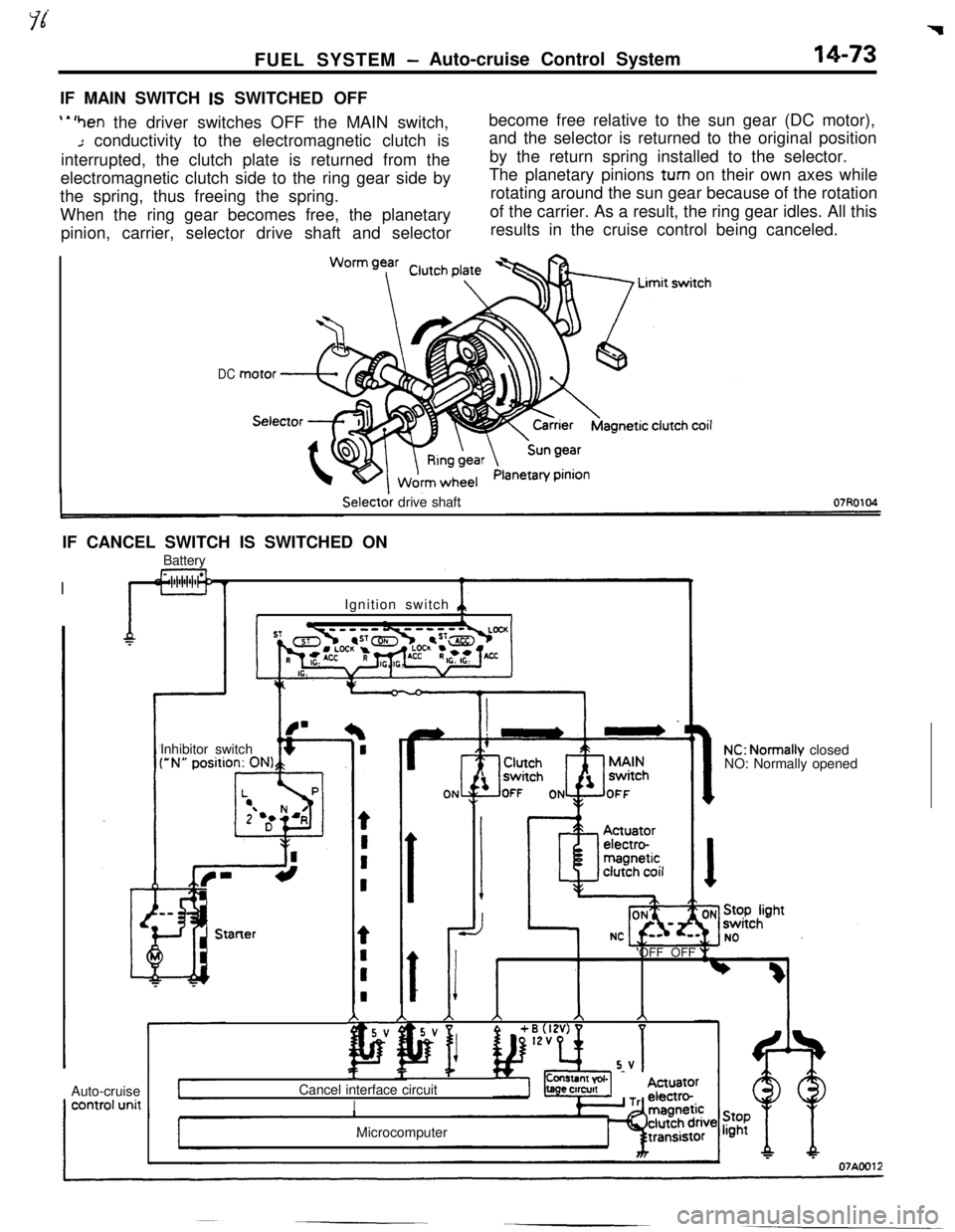
FUEL SYSTEM -Auto-cruise Control System14-73IF MAIN SWITCH
IS SWITCHED OFF
‘*‘hen the driver switches OFF the MAIN switch,
Jconductivity to the electromagnetic clutch is
interrupted, the clutch plate is returned from the
electromagnetic clutch side to the ring gear side by
the spring, thus freeing the spring.
When the ring gear becomes free, the planetary
pinion, carrier, selector drive shaft and selectorbecome free relative to the sun gear (DC motor),
and the selector is returned to the original position
by the return spring installed to the selector.
The planetary pinions
turn on their own axes while
rotating around the sun gear because of the rotation
of the carrier. As a result, the ring gear idles. All this
results in the cruise control being canceled.
DCSelector drive shaft
IF CANCEL SWITCH IS SWITCHED ON
IBattery
IIIIgnition switch 411IInhibitor switch
f’ J
r--
if-Starterz _Auto-cruise
f
AA)\AA
5V
pF p
+ i%zv)
5-VComl
Cancel interface circuit
bs- Tts ec
I
r-
[ON
NC: Normally closed
NO: Normally opened
‘OFF OFF
IMicrocomputer
Page 186 of 391
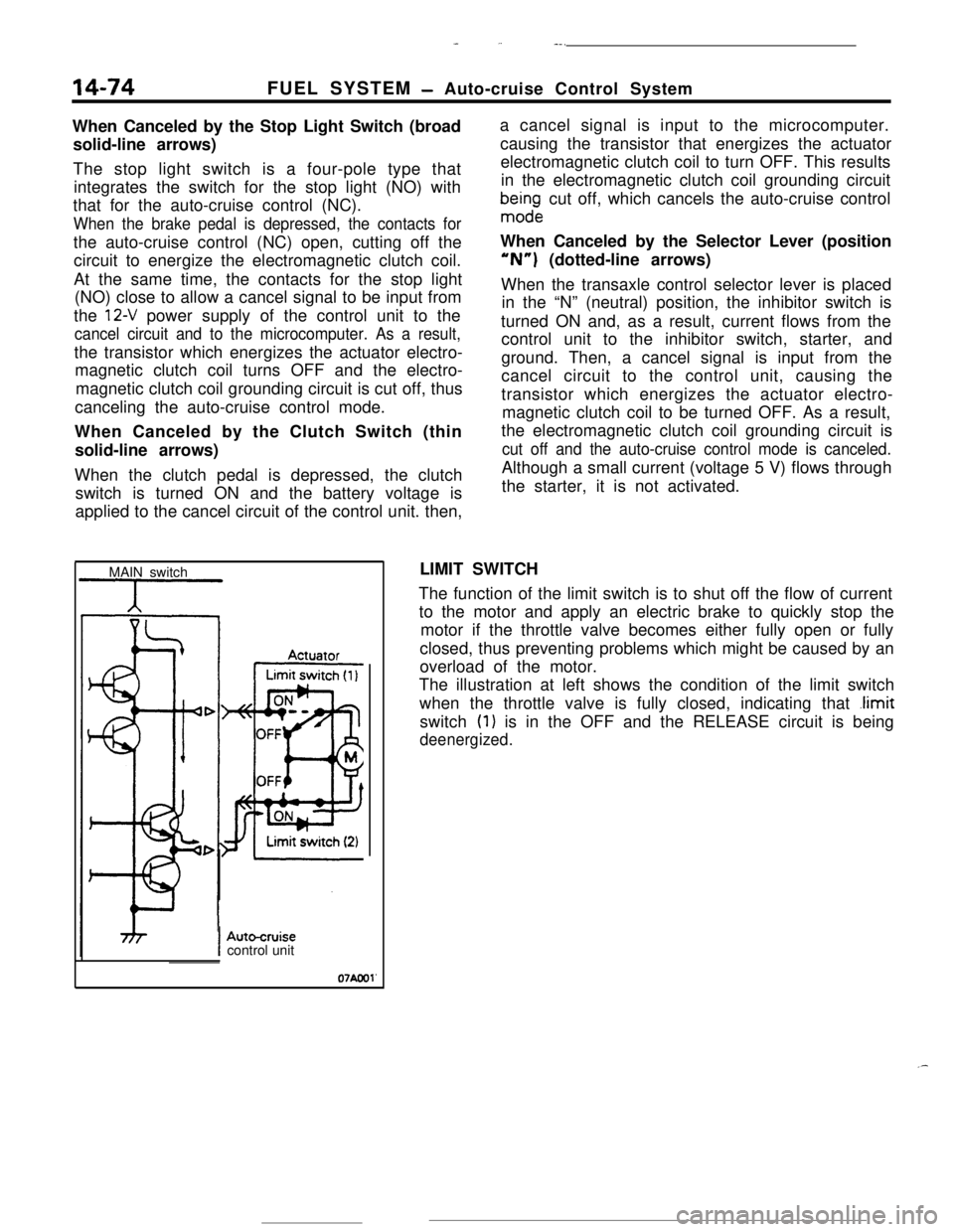
14-74
_ ,.-..FUEL SYSTEM
- Auto-cruise Control System
When Canceled by the Stop Light Switch (broad
solid-line arrows)
The stop light switch is a four-pole type that
integrates the switch for the stop light (NO) with
that for the auto-cruise control (NC).
When the brake pedal is depressed, the contacts forthe auto-cruise control (NC) open, cutting off the
circuit to energize the electromagnetic clutch coil.
At the same time, the contacts for the stop light
(NO) close to allow a cancel signal to be input from
the
12-V power supply of the control unit to the
cancel circuit and to the microcomputer. As a result,the transistor which energizes the actuator electro-
magnetic clutch coil turns OFF and the electro-
magnetic clutch coil grounding circuit is cut off, thus
canceling the auto-cruise control mode.
When Canceled by the Clutch Switch (thin
solid-line arrows)
When the clutch pedal is depressed, the clutch
switch is turned ON and the battery voltage is
applied to the cancel circuit of the control unit. then,a cancel signal is input to the microcomputer.
causing the transistor that energizes the actuator
electromagnetic clutch coil to turn OFF. This results
in the electromagnetic clutch coil grounding circuit
bma$ndge cut off, which cancels the auto-cruise control
When Canceled by the Selector Lever (position“N”) (dotted-line arrows)
When the transaxle control selector lever is placed
in the “N” (neutral) position, the inhibitor switch is
turned ON and, as a result, current flows from the
control unit to the inhibitor switch, starter, and
ground. Then, a cancel signal is input from the
cancel circuit to the control unit, causing the
transistor which energizes the actuator electro-
magnetic clutch coil to be turned OFF. As a result,
the electromagnetic clutch coil grounding circuit is
cut off and the auto-cruise control mode is canceled.Although a small current (voltage 5 V) flows through
the starter, it is not activated.
MAIN switchLIMIT SWITCH
The function of the limit switch is to shut off the flow of current
to the motor and apply an electric brake to quickly stop the
motor if the throttle valve becomes either fully open or fully
closed, thus preventing problems which might be caused by an
overload of the motor.
The illustration at left shows the condition of the limit switch
when the throttle valve is fully closed, indicating that
.limitswitch
(1) is in the OFF and the RELEASE circuit is being
deenergized.
IAutocruisecontrol unit
07Aool'
.-
Page 189 of 391

-- --.-*-.e *._,_-.&” :,.>~‘c,-.y~~ 7, . . --
FUEL SYSTEM- Auto-cruise Control System14-77
(For stop light)
OFF +-ON
0N -+-OFF
(For auto-cruise control)
16RO99r4 3
12
NCNO-w-w
I/0l-COFFOFF*~ON4
321NO: Normally opened
NC: Normally closed
07AOOl:
CANCEL SWITCHESThe cancel switches consist of the stop light switch, the clutch
switch, and the inhibitor switch
(“N” position).
The auto-cruise control operation is canceled if any one ofthese switches functions.
STOP LIGHT SWITCH
The stop light switch is a four-pin type of stop light switch thatcombines the switch for the stop light (NO) and the switch for
the auto-cruise control
(NC).When the brake pedal is depressed, the contacts for the
auto-cruise control (NC) open, the supply of current to the
actuator magnetic clutch is cut off, and the fixed-speed drivingmode is canceled.
At the Same time, the closure of the contacts for the stop lightcauses a cancel signal to be sent to the control unit, and within
the control unit the current supply to the actuator magnetic
clutch is stopped, thus causing the cancellation of the
fixed-speed driving mode.
CLUTCH SWITCH
The contacts of the clutch switch close when the clutch pedal
is depressed, with the result that the cancel signal is sent to
the control unit, thus canceling the fixed-speed driving mode.
INHIBITOR SWITCH
The inhibitor switch is a switch also used in eommon as the
switch for the starter.
If the selector lever is set to the “N” position during
fixed-speed driving, current flows from the control unit to the
inhibitor switch and then to the starter and to ground, with the
result that the cancel signal is input to the microcomputer and
the fixed-speed driving mode is canceled.
Page 225 of 391
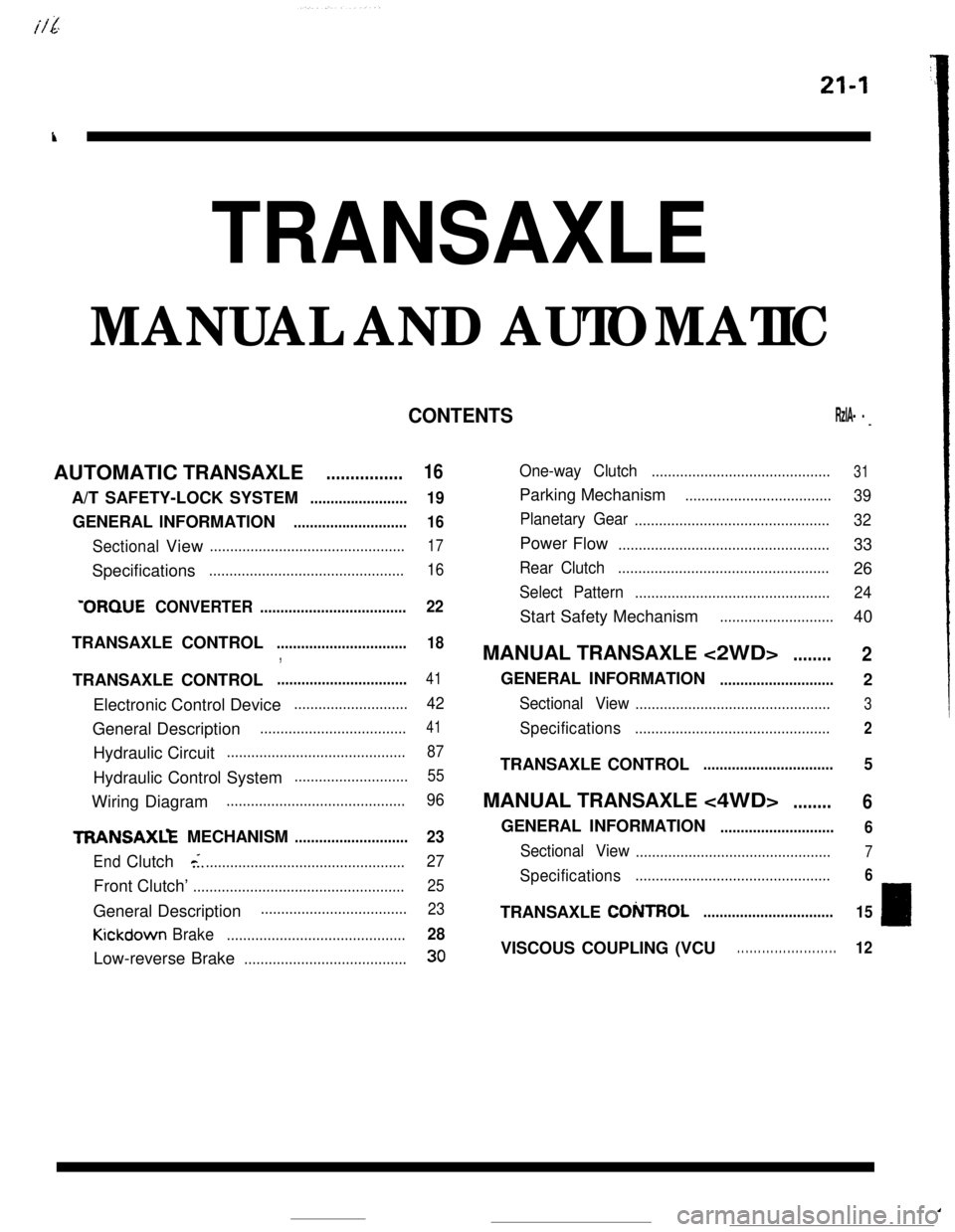
21-l
k
TRANSAXLE
‘TORQUE CONVERTE R....................................22
TRANSAXLZ MECHANIS M............................ 23
EndClutch<.................................................. 27
Front Clutch’.................................................... 25
KickdownBrake............................................ 28
Low-reverse Brake........................................30
One-way Clutch............................................ 31
CObROL................................ 15I
VISCOUS COUPLING (VCU). . . . . . . . . . . . . . . . . . . . . . . . 12
Page 227 of 391
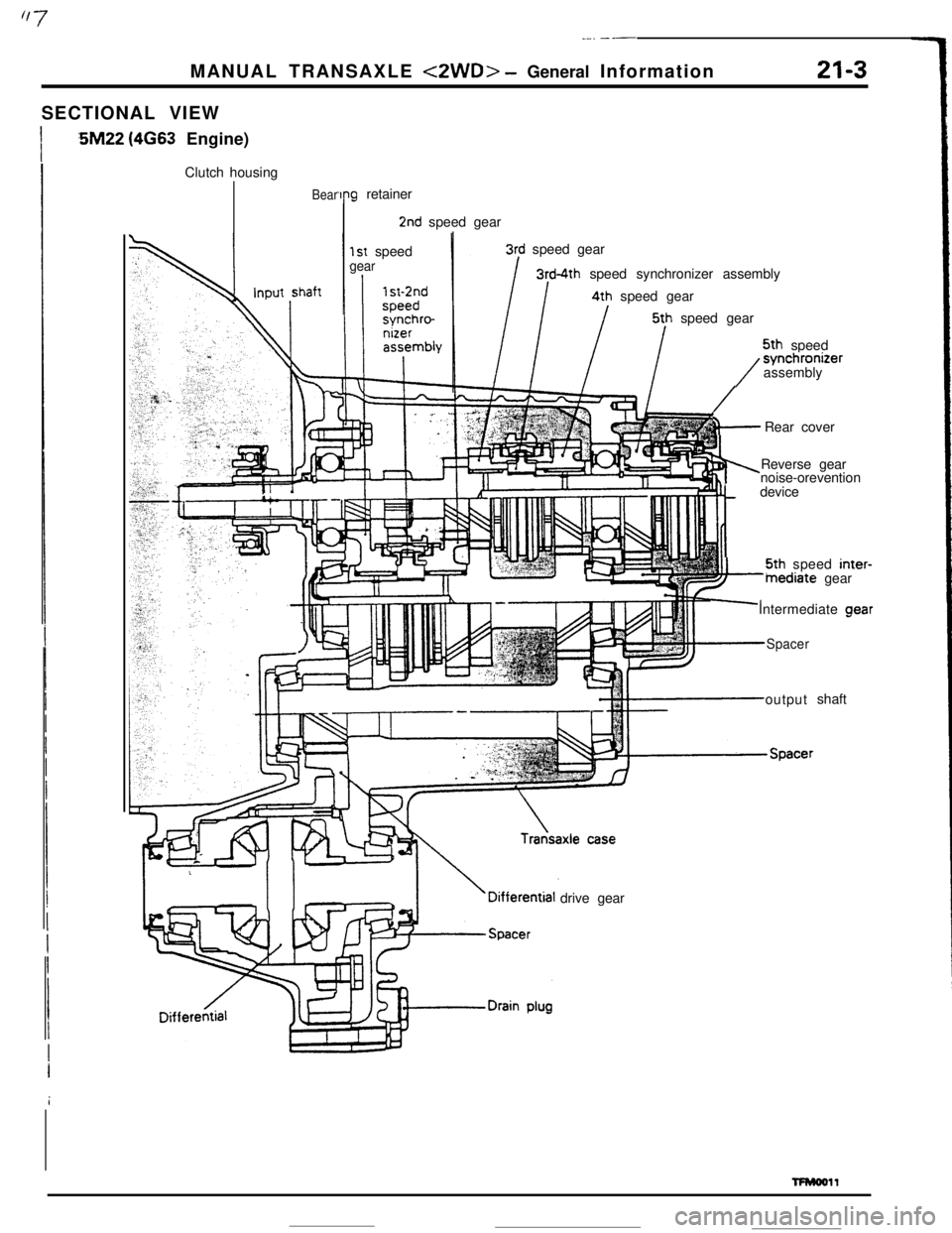
_-. ---MANUAL TRANSAXLE
<2WD> - General Information21-3SECTIONAL VIEW
:5M22 (4663 Engine)
Clutch housing
Bear‘Ing retainer
2nd speed gear
1st speedgear
3rd speed gear
3rd-4th speed synchronizer assembly4th speed gear5th speed gear5th speed
/synchronizer
assembly
ii+-Rear cover
Reverse gear
noise-orevention
tdevice5th speed inter-
inediate gear
Intermediate aear
Spaceroutputshaft
drive gear
TFMooll
Page 228 of 391

MANUAL TRANSAXLE <2WD> - General InformationF5M33
Clutch housing
Bearing retainer
\1st speedgear
2nd speed gear
I3rd speed gear
3rd-4th speed synchronizer assembly
4th speed gear
I5th speed gear
1 st-2nd
speedsynchro-
nizerassembly5th speed
synchronizer
assembly
- Rear Cover
. Reyerse gear
now-prevention
device
-5th speed inter
mediate gear
Intermediate
Differential drive gear
SpacerDrain plug
gear
Page 231 of 391
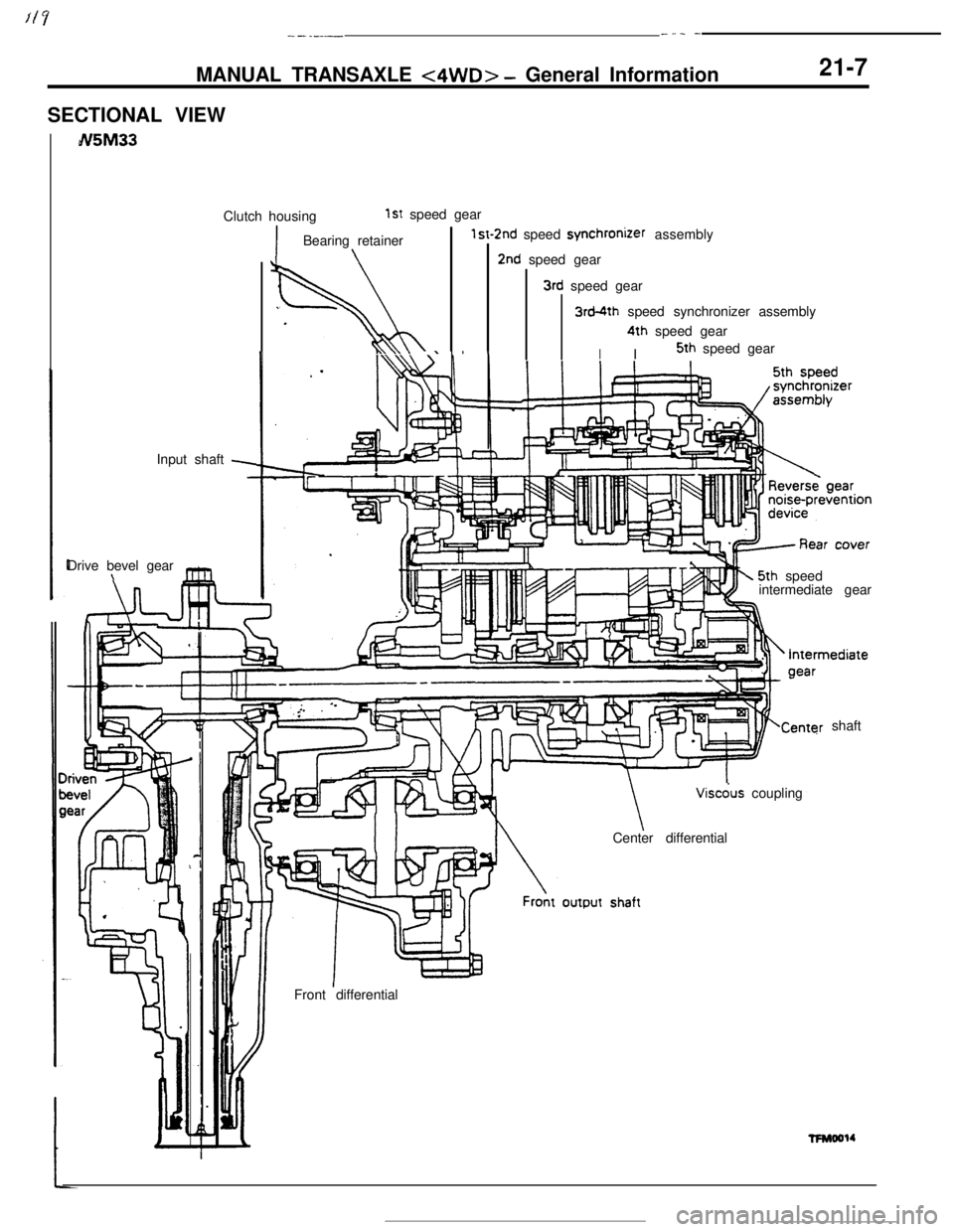
--.-.--_ _ _-MANUAL TRANSAXLE
<4WD> - General Information
SECTIONAL VIEWN5M3321-7Clutch housing
1st speed gear
Input shaft
-Drive bevel gear
\r
l!
.IBearing retainer\
St-1
w
.
I,..\\I \ I I
2nd speed synchronizer assembly
2nd speed gear
3rd speed gear
3rd-4th speed synchronizer assembly
I4th speed gear
I5th speed gear
5th speed
intermediate gear
shaft
Center differential
Front differentialViscdus coupling
wMool4
Page 237 of 391
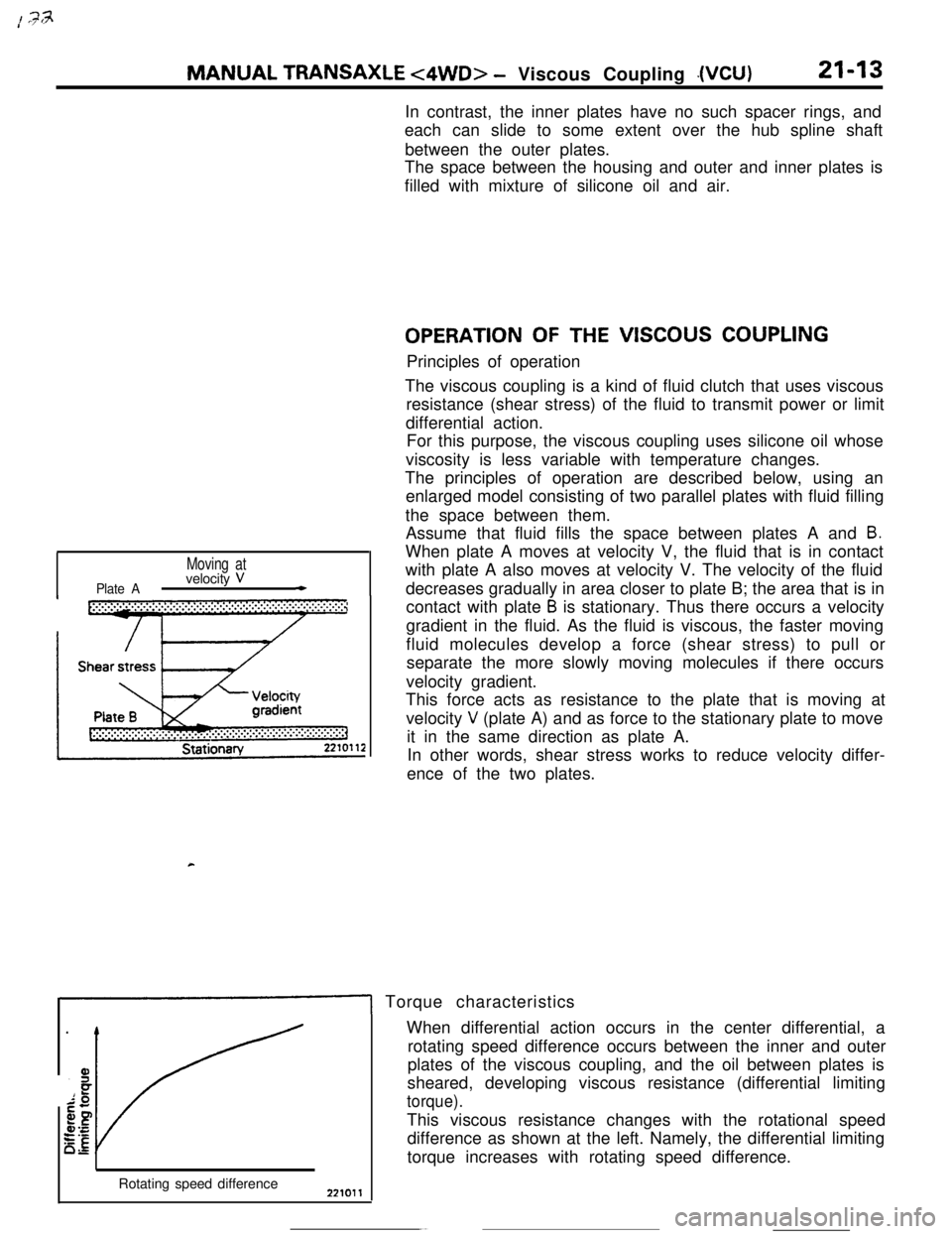
MANUAL TRANSAXLE <4WD> - Viscous Coupling .(VClJ)21-13In contrast, the inner plates have no such spacer rings, and
each can slide to some extent over the hub spline shaft
between the outer plates.
The space between the housing and outer and inner plates is
filled with mixture of silicone oil and air.
Plate A
Moving atvelocity V*
OPERATION OF THE VISCOUS COUPLINGPrinciples of operation
The viscous coupling is a kind of fluid clutch that uses viscous
resistance (shear stress) of the fluid to transmit power or limit
differential action.
For this purpose, the viscous coupling uses silicone oil whose
viscosity is less variable with temperature changes.
The principles of operation are described below, using an
enlarged model consisting of two parallel plates with fluid filling
the space between them.
Assume that fluid fills the space between plates A and
B.When plate A moves at velocity V, the fluid that is in contact
with plate A also moves at velocity V. The velocity of the fluid
decreases gradually in area closer to plate B; the area that is in
contact with plate
B is stationary. Thus there occurs a velocity
gradient in the fluid. As the fluid is viscous, the faster moving
fluid molecules develop a force (shear stress) to pull or
separate the more slowly moving molecules if there occurs
velocity gradient.
This force acts as resistance to the plate that is moving at
velocity
V (plate A) and as force to the stationary plate to move
it in the same direction as plate A.
In other words, shear stress works to reduce velocity differ-
ence of the two plates.
1 Torque characteristics
Rotating speed differenceWhen differential action occurs in the center differential, a
rotating speed difference occurs between the inner and outer
plates of the viscous coupling, and the oil between plates is
sheared, developing viscous resistance (differential limiting
torque).This viscous resistance changes with the rotational speed
difference as shown at the left. Namely, the differential limiting
torque increases with rotating speed difference.
Page 240 of 391
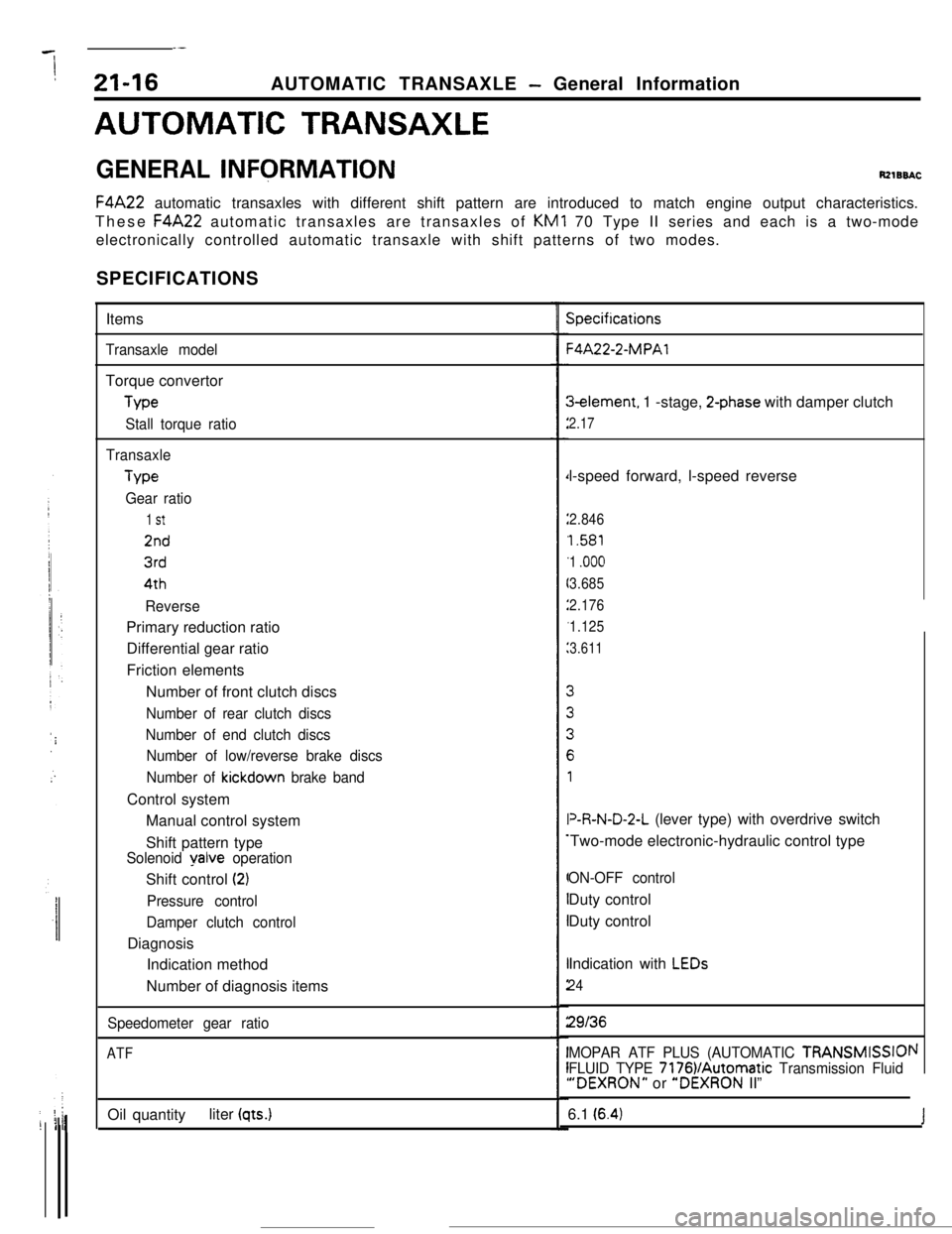
_-
21-16AUTOMATIC TRANSAXLE - General InformationAUTOMATIC
TRANSAXLE
GENERAL INFQRMATIONRzlBBACF4A22 automatic transaxles with different shift pattern are introduced to match engine output characteristics.
These F4A22 automatic transaxles are transaxles of KM1 70 Type II series and each is a two-mode
electronically controlled automatic transaxle with shift patterns of two modes.
SPECIFICATIONS
Items
Transaxle modelTorque convertor
Me
Stall torque ratio
TransaxleType
Gear ratio
1 St
2nd
3rd4th
ReversePrimary reduction ratio
Differential gear ratio
Friction elements
Number of front clutch discs
Number of rear clutch discs
Number of end clutch discs
Number of low/reverse brake discs
Number of
kickdown brake bandControl system
Manual control system
Shift pattern type
Solenoid yalve operationShift control
(2)
Pressure control
Damper clutch controlDiagnosis
Indication method
Number of diagnosis items
Speedometer gear ratio
ATFOil quantityliter
(qts.)
Specifications-4A22-2-MPAl3element, 1 -stage,
2-phase with damper clutch
2.17l-speed forward, l-speed reverse
2.846
1.581
1
.ooo
3.685
2.176
1.125
3.611V&N-D-2-L (lever type) with overdrive switch
Two-mode electronic-hydraulic control type
ON-OFF controlDuty control
Duty control
Indication with
LEDs
24
29136
MOPAR ATF PLUS (AUTOMATIC TRANSMISSIOI
FLUID TYPE 7176VAutomatic Transmission Fluid“DEXRON” or “DEXRON II”
\I6.1
(6.4)J
Page 241 of 391
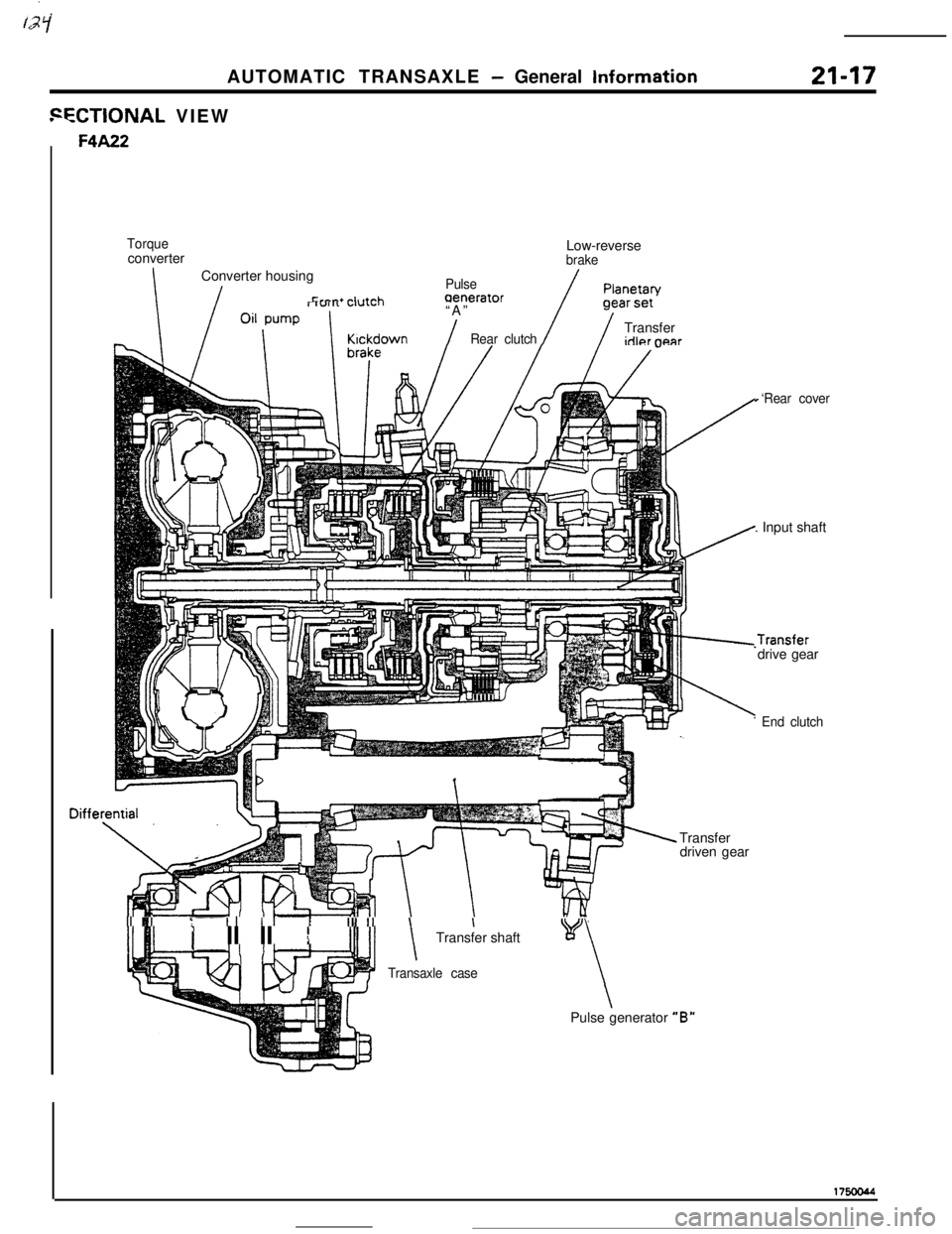
AUTOMATIC TRANSAXLE - General Information21-17
FECTIONAL VIEW
TorqueLow-reverse
converter
brake
IConverter housingIPulse/Planetan/t.mw.+ 4, .+rb-xaeneratormm-r .-Pa+*i, pump rlulll LI”LbII“A”$JGcll JCL
IIKlckdownIRear clutch/ /Transferifilnr mar
I‘Rear cover. Input shaft.Transfer
drive gear
’ End clutchTransfer
driven gear
II
81:-I IIIBII \IKx!J\
II II
f\Transfer shaftK
Transaxle case\
\Pulse generator “B”